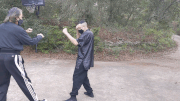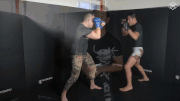I disagree here. Some of the most important things people need to learn, is what it looks like to have someone punch you. It looks different when they are pulling up short or off target and when they mean to hit you. They also need to know what it is like to get hit and what their reaction is to getting hit. These hits do not need to be hard... but the punches should have the intent to make contact with the ability to apply power.
When the punches are done this way from day one, then the students learn about intent, they learn about getting hit and hitting. (I have trained with way too many black belts, across many arts, that have a hard time hitting me... not that my defense is any good, but they panic and pull up when they realize that they are going to make contact with their punch) Many people have to learn how to actually hit another person.
Learning to control yourself and not to panic when someone is trying to hit you, is a major accomplishment for many people. This gives meaning to the distancing, the foot work, the angles, the proper technique.... Learning to do all this stuff right, while someone is hitting you is a very valuable lesson. No, you don't overwhelm them, and pound them.... starting with singles, and doubles and then combos, starting slow and going faster, starting light.... yes to all of that. Learning that you don't die when you get hit and that you can finish your technique after being hit and keep fighting is something people need to experience.
It is not martial arts training, if you don't get hit, kicked, thrown, choked and submitted.
The difference is the timing, the distance, the angles.... Both sides are learning here. The one doing the combo, is learning the correct timing, distancing, foot work, angles to throw the techniques in a way that they hit with power. The defender is learning to defend actual, real attacks that have the intention to make contact. The defender is also learning timing and specifically, where the openings are in the combo, that he can use later. Its not my turn to train while you hold the bag for me.... we both are training at the same time, just different sides of the combo. Training on both sides is extremely useful.


